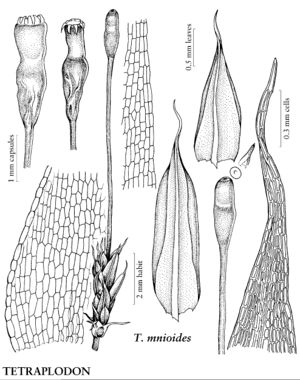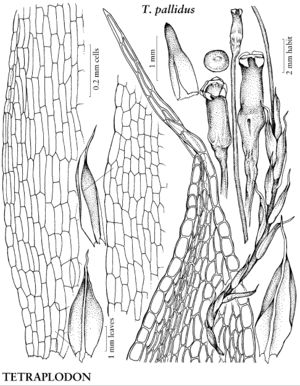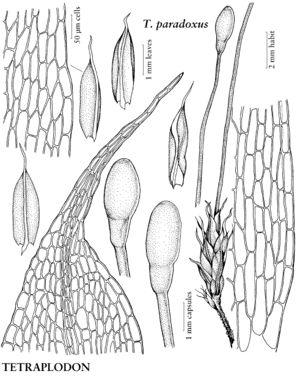Tetraplodon
Bryol. Europ. 3: 211, plates 288 – 290. 1844.
| Taxon | Illustrator ⠉ | |
|---|---|---|
 | Tetraplodon mnioides | Patricia M. Eckel |
 | Tetraplodon pallidus | Patricia M. Eckel |
 | Tetraplodon paradoxus | Patricia M. Eckel |
| ... further results | ||
Plants in dense tufts, often brown proximally, bright green to yellow-green distally. Stems 0.5–3 (–8) cm; often matted with rhizoids proximally. Stem-leaves slender to oblong-lanceolate, or obovate and acuminate; margins toothed or entire; apex acute, acuminate, or subulate; costa usually ending in subula; proximal laminal cells elongate, rectangular; distal cells rectangular, hexagonal, or oblong-hexagonal. Sexual condition autoicous or rarely dioicous. Seta 0.2–5 cm, not twisted. Capsule cleistocarpous or not, yellowish or reddish to dark-brown or black, cylindric to ovoid or spindle-shaped; hypophysis same color or darker than urn, short-to-elongate, narrower to barely wider than urn; annulus usually absent; operculum hemispheric to bluntly conic; peristome single; exostome teeth 16, at first ± coherent in 4’s, later in 2’s, usually reflexed when dry, inflexed when moist, of 2 layers of cells. Calyptra conic-mitrate or cucullate, small, not constricted beyond base. Spores 8–12 µm, smooth or slightly papillose.
Distribution
Nearly worldwide, alpine, subalpine, and temperate to subarctic regions
Discussion
Species 10 (5 in the flora).
Species of Tetraplodon are entomophilous and coprophilous although apparently restricted to the dung of carnivores, bones, and owl pellets. The hypophysis is well developed, elongate, and usually wrinkled when dry; the exostome teeth are connate in 4’s when young but in 2’s as they age; and the seta is stout.
Selected References
None.
Lower Taxa
Key
| 1 | Leaves long-lanceolate; margins with large teeth, occasionally entire. | Tetraplodon angustatus |
| 1 | Leaves ovate or oblong-ovate; margins entire or nearly so | > 2 |
| 2 | Capsules cleistocarpous, clear pale yellow to stramineous; hypophysis conspicuously narrower than urn. | Tetraplodon paradoxus |
| 2 | Capsules not cleistocarpous, usually reddish to black, rarely yellow to stramineous; hypophysis usually as wide or wider than urn | > 3 |
| 3 | Setae shorter than 1 cm; leaf apices broadly acute; costae ending before subula. | Tetraplodon urceolatus |
| 3 | Setae 1-5 cm; leaf apices subulate or acuminate; costae ending in subula | > 4 |
| 4 | Leaf apices abruptly subulate; capsules red, dark red to black with age. | Tetraplodon mnioides |
| 4 | Leaf apices acuminate; capsules pale yellow to stramineous. | Tetraplodon pallidus |